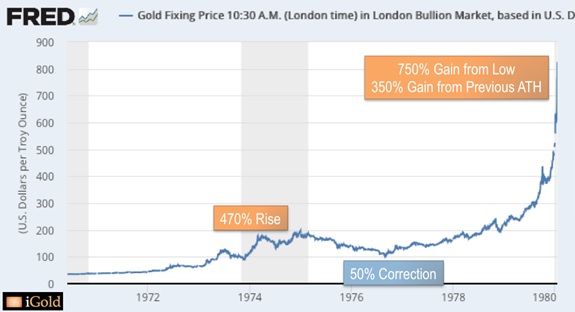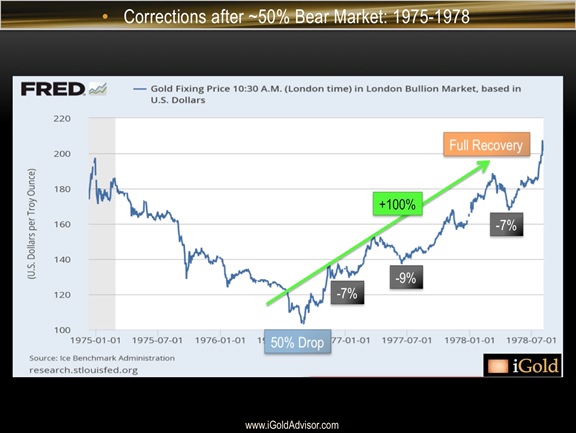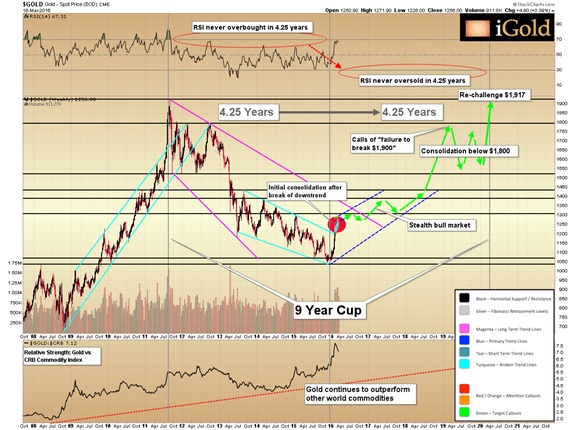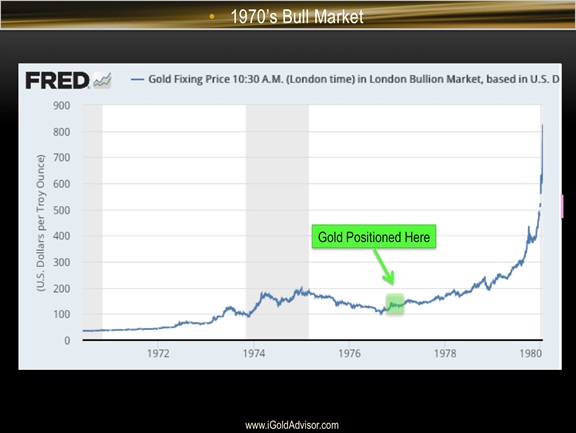Gold Forecast 2021 - Stealth Bull Market
 When it comes to forecasting gold prices, there seem to be two main types of conclusions being offered by analysts these days:
When it comes to forecasting gold prices, there seem to be two main types of conclusions being offered by analysts these days:
1) Gold made a long-term top in 2011, is still in a bear market, and will fall to below $700 per ounce.
2) Gold is going to skyrocket this year and see $5,000, or more,by 2020.
At our firm, we fall into neither extreme. And while our type of analysis may not catch as many quick headlines, we are going to cover, in detail, the trajectory we believe gold prices are setting up for - a distinct third possibility to the aforementioned hypotheses:
3) Gold prices will climb slowly, steadily, and stealthily for the next 4.25 years without a significant pullback, re-challenging $1,900 by 2021.
The Gold Recovery Model
Where do we derive our model from? New readers should have a background understanding of the 1970's bull market in gold to properly understand this analysis.
After rising international gold demand forced President Nixon to abandon the dollar peg in 1971, gold began its first historic run, from $35 to over $850, within the next nine years.
What is often overlooked during this time frame is the fact that this move occurred in two distinct waves. First, from 1971 to 1975, the price rose roughly 470%, from $35 to nearly $200. Next, from 1975 through mid '76, gold lost almost 50% of its value, falling to just above $100. Then from mid '76 to late '77, gold rebounded completely, reaching $200 again by December of 1977. After breaking through $200, the rest was history, as gold prices accelerated for two more years, to the 1980 $850 high.
Note that during the 100% recovery in the 1970's, gold did not register even a single 10% correction.
So we have a precedent for a 50% drop within an overall move higher of almost 2,400% in the 1970's.
Let us also keep in mind the geopolitical backdrop to this time period. The United States was engaged in an unwinnable, overseas war in Vietnam from the early 60's through the mid-70's. While this is not the place for a political debate, suffice it to say that uncontrolled spending for international war is a universal backdrop throughout historical currency devaluations. From the Roman Empire's shaved coins, to the Greenback's collapse during the US Civil War, to Germany's hyperinflation after WWI, to the present wars in Afghanistan and Iraq, gold, it shall be seen, stands in the way of excessive government war spending by forcing discipline on the Treasury.
And what do we have in the current era? Notice how the rise in gold has corresponded nearly perfectly with the still-ongoing 15-year war in Afghanistan, and the 13-year war in Iraq. From my experience in both these wars, I can attest to the fact that both ongoing conflicts, similar to Vietnam, are unwinnable, long-term engagements which have cost the US taxpayer (and human victims) greatly. The only difference is that today, the Treasury simply borrows the extra money it needs in the form of freshly-created dollars from the Fed, as opposed to during Vietnam, when dollars, and hence bonds, were exchanged for gold reserves internationally.
The net result on the price of gold has been nearly identical in both eras.
And while history does not always repeat, is often does.
The Current Model
What we are witnessing now is a model similar to the 1970's, but one that is taking roughly twice as long to play out.
From 2001 to 2011, gold prices rose from $250 to over $1,900, a rise of 650%, very similar to the initial move in the 1970's. From the 2011 high to the December 2015 low at $1,045, gold lost 45% of its value, again strikingly similar to the 1975-76 correction.
Just in February of this year, gold has decisively broken its downtrend that held prices back since 2013. The gold mining sector has moved impulsively higher by 70% in six weeks, a clear sign of an imminent sector turnaround. We thus have two valid signals that the low seen last December was the final low for this bear market.
We are now anticipating that the amount of time it took gold to fall from $1,900 to $1,045, 4.25 years, will be roughly the same amount of time required for prices to regain that level. The chart below shows this trajectory.
Note the break of the downtrend (turquoise color) shown by the red highlight circle above.
We expect prices will now begin a stealth bull market, one that will slope gently upward over the course of the next two years. There may be corrections, but we do not expect any drop to exceed 10-15% in this timeframe. Note that the RSI indicator at the upper part of our chart never approached overbought in the 4.25-year bear market; our expectation is that it will conversely never approach oversold during the next 4.25-year move higher.
Prices are likely to move in a two steps forward, one step backward type of action, hitting each of our clearly-defined black horizontal resistance levels (prices at which sellers emerged from 2011 to 2015) along the way. The first significant resistance level will be the $1,305 level, which was the January 2015 high, followed by the $1,450 region, which represented the high from 2013. This $1,450 level will likely take a period of backing and filling before it is breached at some point in late 2017 or early 2018.
From there, we expect acceleration in the gold market to $1,800, followed by another consolidation through 2020. During this time, we expect many negative sentiments to emerge regarding gold, as most forecasters proclaim that the metal has failed to exceed $1,900, and, therefore, should be sold. However, prices should not fall significantly, but rather consolidate in a range of roughly $1,550-$1,800 for these years, essentially confounding both bulls and bears.
However, the consolidation will eventually break upward, resulting in a re-challenge of $1,900. Our expectation is that it will again take several attempts to break through this level.
This entire 45% correction and full recovery would take nearly nine years and form a similar shape to the cup pattern from the 1970's model.
Some Thoughts On The Model
Note that we are talking about a slow and sustained rise over the next 4.25 years which will see prices rise from $1,250 to $1,900, a gain of 50%. We will be looking at a gain of only 10-20% per year over this time. Psychologically, this will be long and slow enough to allow gold to move without much attention in the mainstream press. Most mainstream investors will not be interested until prices approach $1,800 or higher.
Again, during the 100% recovery during the 1970's, gold did not register even one 10% correction. Such is absolutely within the realm of possibility during this current cycle back to $1,900.
The slow and steady move would truly confound both raging bulls and perma-bears. Bulls looking for high leverage would move on to other asset classes. Bears would be unable to short for a significant profit and would largely leave the market as well.
It would be an excellent environment in which to quietly accumulate physical metal. Select gold mining equities, which tend to lead the price of the metal, would thrive in a steady-to-rising gold-price environment, as the worst thing for the mining sector is uncertainty on projected cash flow.
The Challenge Of $1,900
At some point in 2020-21, a fundamental spark would be the cause for the final challenge and eventual exceeding, of the former $1,900 high. We cannot say, at this juncture, what that fundamental cause will be. It could be a currency devaluation, it could be a bond market dislocation, or it could be a geopolitical event. Whatever the cause, we do not believe it will be the end of the world - no, it will simply cause the gold bull market to go from stealth mode to raging-bull mode, as the public begins to enter the sector en masse. Indeed, gold rose 2,400% in the 1970's without the arrival of Armageddon, so we can remain bullish on gold prices even while we expect a bright future for the world at large.
It is too early to predict the final stage of the gold bull market, but if we were to use the same factor for the final stage in the 1970's - a 350% gain from the $200 high - and apply that to the $1,917 high, it would give us a final target of over $8,600 for the precious metal. Such would represent a true mania, of course, and so, at this time, we offer the calculation simply for comparison and not as something to plan for anytime soon.
Summary On The Forecast
The opportunity looks to be significant in the precious metals market over the coming years. For investors just beginning to learn about gold and the precious metals at this juncture, your timing may just be ideal. The fundamental economic and geopolitical backdrops are in place already. If we can learn anything from the 1970's model, it is that 50% corrections can, and do, happen within the context of a larger move higher, and all signs are now flashing that we have just seen the end of such a correction in gold.






















